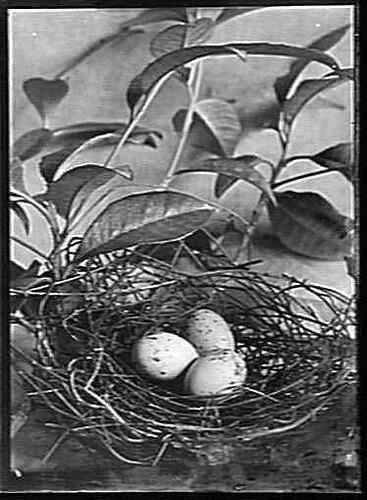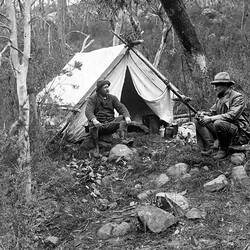YELLOW-BELLIED FIG BIRD (Specotheres Flaviventris, Gould - 287)
Geographical Distribution - Northern Territory, Queensland and New South Wales, also Ké Islands.
Nest - Open, shallow; composed of wire-like stalks or tendrils of plants, and lined inside with brownish twigs. The structure can be easily seen through from beneath. Several nests are usually placed in the topmost horizontal branches of a tall eucalypt. Dimensions over all, 5 inches by 3 inches in depth; egg cavity, 3½ inches across by 1½ inches deep.
Eggs - Clutch, two to three; oval in shape; texture of shell moderately fine; surface glossy; colour, varies from a delicate green to olive-brown, but usually pale or light green, moderately spotted and blotched with rufous or reddish-brown and purplish-brown. Similar to those of the Southern Fig Bird. Dimensions in inches of a pair: (1) 1.23 x .91, (2) 1.2 x .92. (Plate 6)
Observations - The Yellow-bellied Fig Bird is usually confined to Northern Australia and some of the islands beyond. However, Mr. S. W. Jackson noticed in the Clarence district of New South Wales, January, 1890; and another season subsequently, during the same month, he saw numbers of the bird at Byron Bay, where he shot a pair. The male is a beautiful creature, its rich jonquil-yellow under surface being shown off to perfection with aesthetic olive-green coat and glossy black cap, and eyes surrounded by bright crimson orbits. The female differs from her lord in being olive-brown with streaked markings like her cousins, the Orioles. Total length, 10 ½ inches; wing, 5 ¾ inches; bill, 1 1/8 inches; tail, 4 ¼ inches; tarsus, 7/8 inch.
The most striking birds that visited the precincts of our camp at Cardwell were the males of this species. They often, especially in the morning, perched on the summit of the very trees to which our tents were suspended, and poured forth over our heads beautiful songs not altogether unlike those of the English Thrush. As in the case of the Yellow Oriole, we were much too early in the season for eggs. Macgillivray, a valuable correspondent of Gould, reported that once at Cape York he saw several nests which he (Macgillivray) which he entertained no doubt belongs to this bird; nearly all of them were built among the topmost branches of very large gum-trees, which the natives could not be induced to climb. However, it was left to Mr. Dudley Le Souëf years after to bring to scientific light the nest and eggs. He found the birds plentiful in the open country in the Bloomfield River district, and, as Macgillivray also noticed, often in company with Friar Birds (Philemon).
Mr. Le Souëf's own words are: - 'We noticed them building on a small white gum-tree, on 18th October (1893), and found five of their nests on the tree, also that of a Silvery-crowned Leatherhead (P. argenti-ceps); they were all built near the ends of thin boughs, and only one could be got by our native climber. We could see from below how many eggs were in each nest, the full clutch being three. Our blackfellow had a long thin stick, and the nests he could not get at, he rolled the eggs out one by one, and I caught them all uninjured in my hat as they fell.' A field note, kindly sent me from Mr. W. B. Barnard, states that at Bloomfield River he found theYellow-bellied Fig Bird breeding in the month of January. At the extreme north (Cape York) his brother, Mr. Harry Barnard, in 1896 took the following nests: - In October, four nests, two with each three eggs and two with two; November, two with each three eggs, December, one with two eggs. Usual breeding months October to January.
Resources
Transcribed Archibald James Campbell. Nests and Eggs of Australian Birds, including the Geographical Distribution of the Species and Popular Observations Thereon, Pawson & Brailsford, Sheffield, England, 1900. Transcribed from pp. 84-85.
More Information
-
Keywords
-
Authors
-
Contributors
-
Article types


